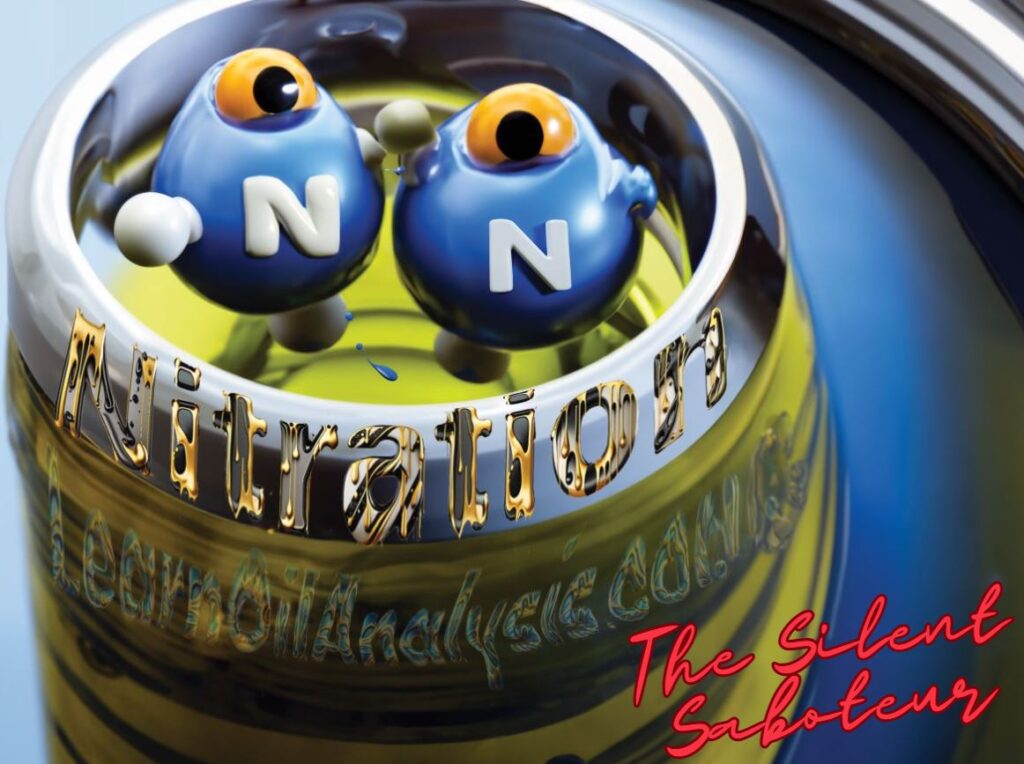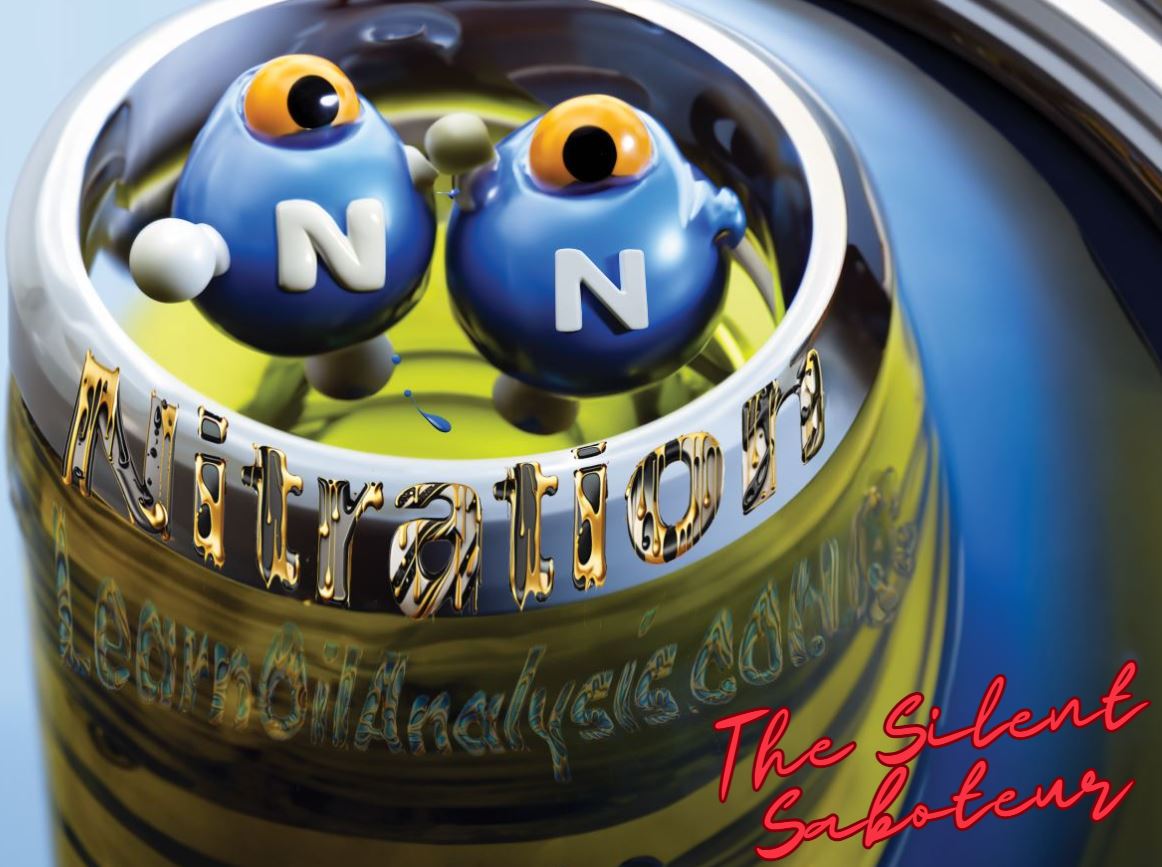
When we talk about oil degradation we often use the terms contamination and oxidation. In fact you only need to look at any oil product data-sheet to see terms such as “increased oxidation resistance”, “superb oxidation stability” yet you never hear mentioned of nitration. Nitration is hence often regarded as the silent disruptor in the world of lubricating oil and is little understood or discussed. Nitration introduces nitrogen compounds into oil, subtly undermining its quality and performance. The story of nitration is one of chemical reactions, engine operations, and, ultimately, proactive machinery maintenance.
The Science Behind Nitration
Nitration is fundamentally a chemical process that starts with nitrogen (N2), it’s thermal breakdown to form nitrogen oxides (NOx), which eventually chemically react with the oil. These NOx compounds, specifically nitrogen dioxide (NO2), diffuse into the lubricating oil and instigate a series of reactions, leading to nitration.
Let’s delve into the mechanics of this process. The combustion of fuel in an internal combustion engine generates a variety of gases, including nitrogen oxides. While nitrogen is generally unreactive due to the stability of its molecule (see explainer below for why it is so stable), it can form nitrogen oxides when subjected to high temperatures and pressures in combustion chambers. It is the nitrogen oxides that cause the breakdown of the oil.
Why is nitration need higher temperatures to form?
Nitrogen needs higher temperatures to form compared to oxidation because of the chemical structure of Oxygen (O2) vs Nitrogen (N2). Even for the non chemist you can likely work out that oxygen and nitrogen exist naturally in pairs (hence the 2), but how they link together differs. Imagine the two dogs on separate leads and you join the two leads together with a single piece of string . Normally they are happy to go in one direction together but should they have different things to excite them say a ball to the left and a stick to the right they will pull in opposing directions. The piece of string that tied the leads prevent them separating the leads stay together. However if they pull strong enough the string could snap and they are no longer joined. This string in this case is a covalent bond between the dogs (atoms) and has been broken with excitement (heat). Oxygen has two pieces of string joining the leads together so you need quite a bit of excitement to break them. Perhaps a “here boy” encouragement might get the excitement to pull apart and break both strings (covalent bonds). However the owner of the two nitrogen puppies is very pedantic and has not one, not two like oxygen, but THREE pieces of string to hold the leads together. In this case the dogs have to be practically frantic perhaps with a juicy steak in front of each of their noses too to break all 3 strings. Hence in our analogy nitrogen requires far more energy to chemically break than oxygen and hence higher temperatures.
When these nitrogen oxides come into contact with the lubricating oil, they react with the hydrocarbons in the oil to form organic nitrates and nitrites, effectively nitrating the oil. This nitration can lead to the formation of harmful acidic compounds, resulting in increased oil viscosity and a decrease in overall oil health.
Nitration and Engine Operations
The rate of nitration is closely tied to engine operating conditions. Higher combustion chamber temperatures and pressures, often seen in engines operating under heavy loads or those with high exhaust gas recirculation rates, accelerate the nitration process.
Engines with rich air-fuel mixtures or those that experience extended idling periods are particularly prone to nitration. These conditions promote incomplete combustion and increase the generation of nitrogen oxides, leading to increased nitration of the oil.
It’s not just the oil that has a problem with nitrogen oxides
Nitrogen oxides are not just a problem for your engine oil but also are the cause of acid rain and why engine manufacturers invest so heavily in reducing these emissions with the use of products such as Adblue and your catalytic converter to reduce the NOx coming out your exhaust. NOx when combined with water form nitric acid and cause devastating effects on the environment. The same is true in your engine and that is why we want to monitor its presence regularly.
Detecting Nitration: The Role of Oil Analysis
Detecting nitration early is critical to maintaining oil health and preventing potential engine damage.
Detecting nitration in a laboratory setting primarily relies on spectroscopic techniques, particularly Fourier Transform Infrared (FTIR) spectroscopy. This powerful method of analysis allows scientists to scrutinize the oil’s chemical composition, unearthing the subtle but significant alterations caused by nitration.
FTIR spectroscopy operates on the principle that different molecular structures absorb infrared light at distinctive frequencies, generating a unique spectrum – akin to a chemical ‘fingerprint.’ When examining oil for nitration, the instrument directs an infrared light beam at the oil sample and measures how much light is absorbed at various wavelengths, each a signature of different chemical bonds present. Nitration in oil produces specific absorption bands, and by examining these bands, scientists can gauge the level of nitration.
One critical absorption band associated with nitration lies around 1600 Abs/cm on the infrared spectrum. This band corresponds to the nitro groups (NO2) that are indicative of nitration. A higher absorption around this band indicates a greater presence of nitro compounds, suggesting increased nitration. By comparing the intensity of absorption in this band to established standards or baseline oil readings, lab technicians can quantify the nitration level and provide essential insights into the oil’s health. This information forms a crucial part of maintaining optimal machinery performance, helping to preempt issues before they lead to significant damage.
Higher values, typically above 20 or 30 Abs/cm in oils, indicate elevated nitration levels and suggest potential oil thickening, sludging, varnish laquering, acidic corrosion, and suboptimal system performance.
Addressing Nitration: Proactive Measures
Should high nitration levels be detected in your oil analysis, it’s necessary to take action. Consider adjusting engine operating conditions, particularly those that may be leading to increased combustion chamber temperatures or pressures. Below is a brief check list you can think of when looking at high nitration readings on how to resolve.
1. Investigate the Cause
- Determine if the engine is running under heavy load conditions or at high temperatures, as these conditions can accelerate nitration.
- Check if there’s excessive idling or if a rich fuel-air mixture is being used, as these could also contribute to nitration.
2. Review Engine Conditions
- Consider adjusting engine operating conditions. Reducing the load or operating temperature might help slow down the nitration process.
- Check for signs of poor system cooling and test the condition of your engine coolant if liquid cooled.
- If the engine is idling excessively, try to minimise these periods as they can lead to incomplete combustion and increased nitration.
3. Check the Air-Fuel Mixture
- Ensure the engine isn’t running rich. A mixture that’s too rich can cause incomplete combustion, producing higher levels of nitrogen oxides and accelerating nitration.
4. Evaluate the Oil Being Used and Drain Intervals
- Assess whether your current oil is resistant to nitration. High-quality base stocks and high antioxidant contents are the things to consider. Although normally considered in terms of oxidation resistance antioxidants act as sacrificial pawns protecting your oil from any free radicals whether nitrogen oxides or just oxides, whilst high quality base oils give fewer reaction sites (chinks in the oils armour) for both nitration and oxidation to occur.
- If nitration is an ongoing issue, consider increasing the frequency of oil changes and work with an oil change interval that is condition rather than time based wherever possible. This can help reduce the overall nitration level in the system.
Remember, these actions are most effective when performed proactively and consistently as part of a comprehensive engine maintenance strategy.
Conclusion
Understanding nitration is vital in the realm of oil analysis. By comprehending its chemical foundations and operational influences, you can effectively predict, identify, and mitigate this silent saboteur. Engage with oil analysis and make it an integral part of your engine maintenance strategy. Through proactive management, you’ll ensure your machinery’s optimal performance and longevity.
If you would like to find out about your oil condition or have any questions about this article please use the contact us button below to get in touch.


